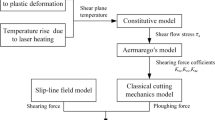Abstract
Laser transformation hardening is effective technique used for selective hardening of components such as turbine blade, camshafts and gears. Laser hardening provides benefits over other selective hardening processes in terms of thermal distortion, control of process and appearance of component. The fiber laser is relatively recent development. The single/low mode fiber lasers have good beam quality, high wall plug efficiency, fiber delivery and powers up to few hundred watts. The beam quality of single mode fiber lasers enable it to be focused to a spot size of few tens of mm which can yield hardened tracks of 100 to 500 mm. These fiber lasers can be extremely useful in localized micro-scale surface hardening to create hardened patterns for improving the wear resistance. This paper is focused on developing analytical thermal model of moving heat sources and integrating it with kinetic hardening model to capture the metallurgical changes induced by fiber lasers. An ideal surface hardening technique should give widest hardened track at minimum case depth. To address this issue, an optimization methodology based on statistical approximation of the physics-based engineering models has been developed.
Similar content being viewed by others
Abbreviations
- K:
-
Thermal conductivity (W/mm·K)
- ρ :
-
Density (kg/mm3)
- C:
-
Specific heat capacity (J/kg·K)
- a:
-
Diffusivity (mm2/s)
- I(x, y):
-
Heat intensity (W/mm2)
- T:
-
Temperature (C)
- T0 :
-
Ambient temperature (C)
- t:
-
time (s)
- P:
-
Laser power (W)
- A:
-
Area under heat source (mm2)
- σ :
-
Beam radius (mm)
- AC1 :
-
Eutectoid temperature (C)
- AC3 :
-
Austenization temperature (C)
- Q:
-
Activation energy for transformation (kJ/mol)
- R:
-
Gas constant (J/mol·K)
- τ :
-
Thermal time constant (s)
- Tp:
-
Peak temperature (C)
- D:
-
Diffusion coefficient (mm2/s)
- D0 :
-
Pre-exponential coefficient of C diffusion in ferrite (mm2/s)
- Ce :
-
Austenite C percentage (0.8%)
- Cc :
-
Ferrite C percentage (0.05%)
- fm :
-
Maximum volume fraction of martensite permitted
- fi :
-
Volume fraction of pearlite (C/0.8)
References
Rosenthal, D., “The Theory of Moving Sources of Heat and Its Application to Metal Treatments,” Transactions of the American Society of Mechanical Engineers, Vol, 68, No. 11 pp. 849–866, 1946.
Jaeger, J. C., “Moving Sources of Heat and the Temperature of Sliding Contacts,” Journal and proceedings of the Royal Society of New South Wales. Vol. 76, pp. 203–224, 1942.
Mazumder, J. and Steen, W. M., “Heat Transfer Model for CW Laser Material Processing,” Journal of Applied Physics, Vol. 51, No. 2, pp. 941–947, 1980.
Cline, H. E. and Anthony, T. R., “Heat Treating and Melting Material with a Scanning Laser or Electron Beam,” Journal of Applied Physics, Vol. 48, No. 9, pp. 3895–3900, 1977.
Hou, Z. B. and Komanduri, R., “General Solutions for Stationary/ Moving Plane Heat Source Problems in Manufacturing and Tribology,” International Journal of Heat and Mass Transfer, Vol. 43, No. 10, pp. 1679–1698, 2000.
Ashby, M. F. and Easterling, K. E., “The Transformation Hardening of Steel Surfaces by Laser Beams-I. Hypo-eutectoid Steels,” Acta Metallurgica, Vol. 32, No. 11, pp. 1935–1948, 1984.
Steen, W. M. and Courtney, C., “Surface Heat Treatment of EnS Steel using a 2kW Continuous-wave CO2 Laser,” Metals Technology, Vol. 6, No. 1, pp. 456–462, 1979.
Skvarenina, S. and Shin, Y. C., “Predictive Modeling and Experimental Results for Laser Hardening of AISI 1536 Steel with Complex Geometric Features by a High Power Diode Laser,” Surface and Coatings Technology, Vol. 201, No. 6, pp. 2256–2269, 2006.
Lakhkar, R. S., Shin, Y. C., and Krane, M. J. M., “Predictive Modeling of Multi-Track Laser Hardening of AISI 4140 Steel,” Materials Science and Engineering: A, Vol. 480, No. 1-2, pp. 209–217, 2008.
Selvan, J. S., Subramanian, K., and Nath, A., “Effect of Laser Surface Hardening on En18 (AISI 5135) Steel,” Journal of Materials Processing Technology, Vol. 91, No. 1, pp. 29–36, 1999.
Singh, R. K., Joseph, V. R., and Melkote, S. N., “A Statistical Approach to the Optimization of a Laser-Assisted Micromachining Process,” The International Journal of Advanced Manufacturing Technology, Vol. 53, No. 1-4, pp. 221–230, 2011.
Wagh, Y., Chukewad, Y., Gupta, N. and Singh, R., “Experimental Investigation of Micro-scale Fiber Laser based Surface Hardening,” Proc. of 6th International Conference on Micromanufacturing, 2011.
Carslaw, H. S. and Jaeger, J. C., “Conduction of Heat in Solids,” Clarendon Press Oxford, 2nd Ed., pp. 353–386, 1959.
Shercliff, H. R. and Ashby, M. F., “The Prediction of Case Depth in Laser Transformation Hardening,” Metallurgical Transactions A, Vol. 22, No. 10, pp. 2459–2466, 1991.
Author information
Authors and Affiliations
Corresponding author
Rights and permissions
About this article
Cite this article
Gupta, N., Ahirrao, S.B., Paul, S. et al. Modeling of micro-scale fiber laser hardening process and optimization via statistical approximation of the engineering models. Int. J. Precis. Eng. Manuf. 16, 2281–2287 (2015). https://doi.org/10.1007/s12541-015-0293-9
Received:
Revised:
Accepted:
Published:
Issue Date:
DOI: https://doi.org/10.1007/s12541-015-0293-9




